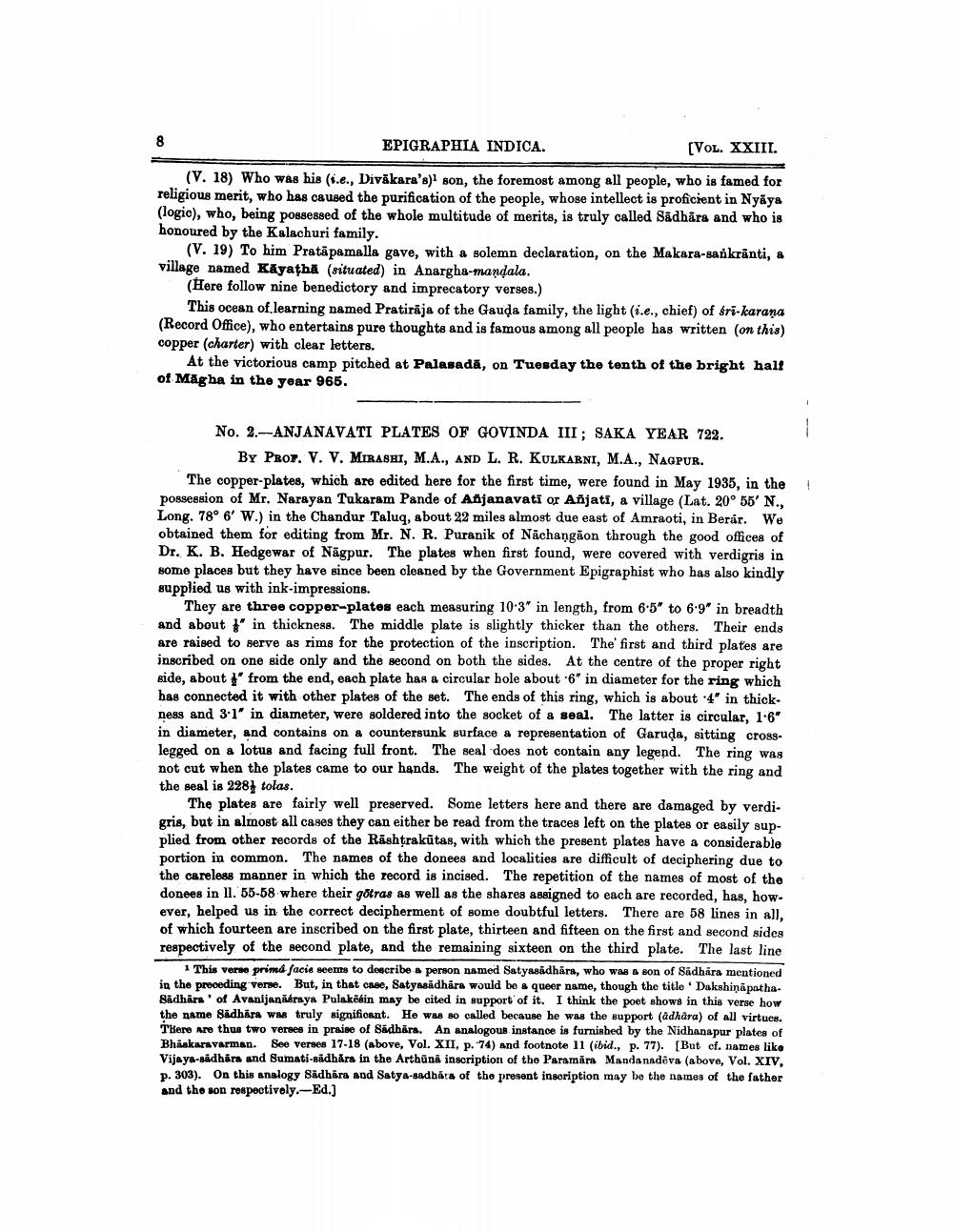________________
8
EPIGRAPHIA INDICA.
[VOL. XXIII.
(V. 18) Who was his (i.e., Diväkara's) son, the foremost among all people, who is famed for religious merit, who has caused the purification of the people, whose intellect is proficient in Nyaya (logic), who, being possessed of the whole multitude of merits, is truly called Sadhara and who is honoured by the Kalachuri family.
(V. 19) To him Pratapamalla gave, with a solemn declaration, on the Makara-sankranti, a village named Kayatha (situated) in Anargha-mandala.
(Here follow nine benedictory and imprecatory verses.)
This ocean of learning named Pratiraja of the Gauḍa family, the light (i.e., chief) of śrī-karana (Record Office), who entertains pure thoughts and is famous among all people has written (on this) copper (charter) with clear letters.
At the victorious camp pitched at Palasada, on Tuesday the tenth of the bright half of Magha in the year 965.
No. 2.-ANJANAVATI PLATES OF GOVINDA III; SAKA YEAR 722.
BY PROF. V. V. MIRASHI, M.A., AND L. R. KULKARNI, M.A., NAGPUR.
The copper-plates, which are edited here for the first time, were found in May 1935, in the possession of Mr. Narayan Tukaram Pande of Añjanavati or Añjati, a village (Lat. 20° 55' N., Long. 78° 6' W.) in the Chandur Taluq, about 22 miles almost due east of Amraoti, in Berár. We obtained them for editing from Mr. N. R. Puranik of Nachangaon through the good offices of Dr. K. B. Hedgewar of Nagpur. The plates when first found, were covered with verdigris in some places but they have since been cleaned by the Government Epigraphist who has also kindly supplied us with ink-impressions.
They are three copper-plates each measuring 10.3" in length, from 6'5" to 6.9" in breadth and about " in thickness. The middle plate is slightly thicker than the others. Their ends are raised to serve as rims for the protection of the inscription. The' first and third plates are inscribed on one side only and the second on both the sides. At the centre of the proper right side, about from the end, each plate has a circular hole about 6" in diameter for the ring which has connected it with other plates of the set. The ends of this ring, which is about 4" in thick. ness and 3.1" in diameter, were soldered into the socket of a seal. The latter is circular, 1.6" in diameter, and contains on a countersunk surface a representation of Garuda, sitting crosslegged on a lotus and facing full front. The seal does not contain any legend. The ring was not cut when the plates came to our hands. The weight of the plates together with the ring and the seal is 228 tolas.
The plates are fairly well preserved. Some letters here and there are damaged by verdigris, but in almost all cases they can either be read from the traces left on the plates or easily supplied from other records of the Rashtrakutas, with which the present plates have a considerable portion in common. The names of the donees and localities are difficult of deciphering due to the careless manner in which the record is incised. The repetition of the names of most of the donees in 11. 55-58 where their götras as well as the shares assigned to each are recorded, has, however, helped us in the correct decipherment of some doubtful letters. There are 58 lines in all, of which fourteen are inscribed on the first plate, thirteen and fifteen on the first and second sides respectively of the second plate, and the remaining sixteen on the third plate. The last line
1 This verse prima facie seems to describe a person named Satyasädhära, who was a son of Sadhara mentioned in the preceding verse. But, in that case, Satyasadhara would be a queer name, though the title DakshinapathaSädhära of Avanijanäéraya Pulakesin may be cited in support of it. I think the poet shows in this verse how the name Sadhara was truly significant. He was so called because he was the support (ädhära) of all virtues. There are thus two verses in praise of Sadhara. An analogous instance is furnished by the Nidhanapur plates of Bhaskaravarman. See verses 17-18 (above, Vol. XII, p. 74) and footnote 11 (ibid., p. 77). [But cf. names like Vijaya-sadhara and Sumati-sadhara in the Arthuna inscription of the Paramara Mandanadeva (above, Vol. XIV, p. 303). On this analogy Sadhara and Satya-sadhara of the present inscription may be the names of the father and the son respectively.-Ed.]




